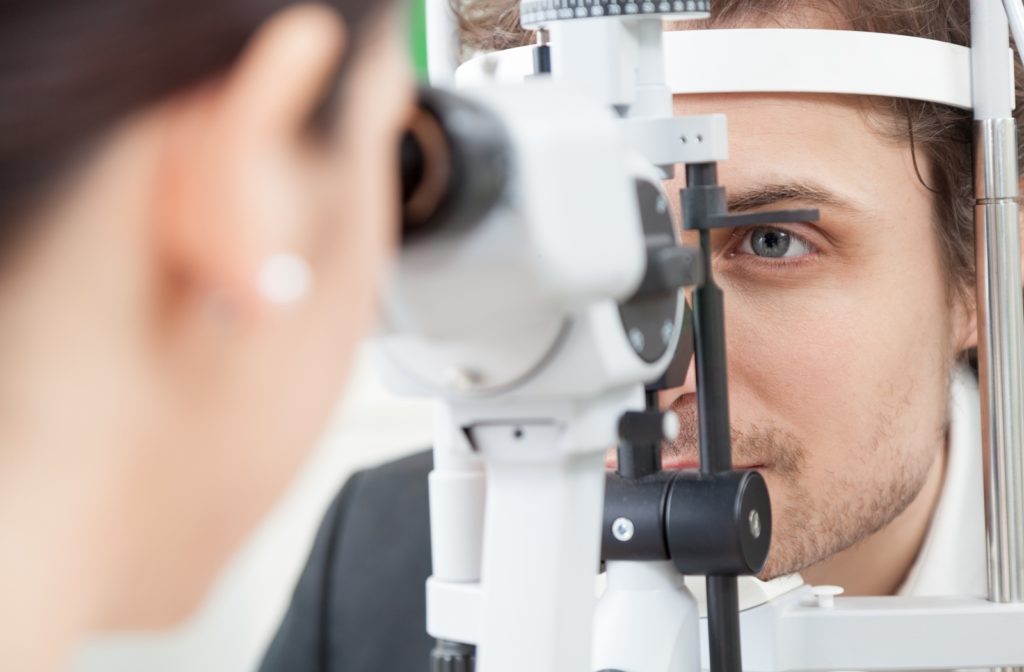Eye exams are important for your ocular health, but what happens during them? This exam is more than a vision assessment—your optometrist has several tests they’ll use to look for signs of eye disease.
What should you expect during your examination? Continue reading to learn more about eye exams, including what happens during your appointment.
Eye Exams Help Protect Your Eye Health
Eye exams help assess your vision and eye health. An eye exam consists of several tests that look at different parts of your eyes.
No matter your age, everyone needs regular examinations. However, the frequency can vary. For the most part, you should have an eye exam once per year.
Even if your vision seems good, an annual exam is the best way to detect eye health issues and vision changes early. Make sure to ask your optometrist how often you should have an eye exam. You may need exams more often if you have a history of eye disease, for example.
Why Are Eye Exams Important?
Eye exams are needed to identify eye diseases before they damage your vision. Many conditions can develop without noticeable symptoms, and the only way to identify them is through an eye exam. Your eye doctor has access to the tools needed to catch early signs of these diseases.
Early detection is crucial for preventing vision loss from many eye conditions. Your optometrist can begin treatment sooner after catching an eye condition early in its development.
Regular examinations can help your eye doctor track any changes to your vision and evaluate how current treatments are going. What happens during your eye exam?
What Happens During Your Eye Exam?
A comprehensive eye exam is more than an assessment of how well you see. An eye exam consists of many different tests used to evaluate your eye health and identify any present problems. Your optometrist will look at the entirety of your eye during their assessment.
You may not experience every test available, but your eye doctor will determine the most effective tests for your ocular needs. You can expect the following during your next appointment:
Medical History
The beginning of an eye exam usually begins with a discussion about your medical history. Your eye doctor will ask questions related to your health, including:
- Current medications you’re taking
- Current issues you’re facing
- Previous medical history
- Work & home conditions
- Family history

Visual Acuity & Refraction
Your visual acuity is how well you can see from different distances. Your eye doctor tests your vision using a Snellen eye chart. If you struggle to read the chart, you may have a refractive error such as:
Afterward, your optometrist will conduct a refraction test using a phoropter. This device helps them determine the lens power needed to correct any present refractive errors. At CHROMA modern Eyewear Eyecare, we have many digital options to assist in our eye exams. These digital options include digital phoropter and digital eye chart versus a traditional phoropter and Snellen eye chart.
Preliminary Tests
There are several preliminary tests your eye doctor may conduct during your exam. These tests look at different aspects of your vision and eye health. Your optometrist can evaluate your:
Eye Coordination
Your eyes need to move, focus, and work together to see clear images. Each eye sees a different image than the other, and your brain fuses them into one. A poor connection between the eyes and the brain can affect how well you see.
Your eye doctor assesses how your eyes work together during your examination. These tests look at how your eyes focus together and your binocular vision.
Glaucoma Testing
Glaucoma can lead to irreversible damage, and you may not notice until it’s too late. This condition can develop without any visible symptoms until your vision is affected. Because of the risk glaucoma presents, it’s vital your optometrist tests for this condition regularly.
Many but not all types of glaucoma can raise the pressure inside your eye. Your optometrist will use a tonometry test to measure your intraocular pressure.
Eye Health Evaluation
Your optometrist uses several types of technology to assess your overall eye health. This evaluation looks at the structures of your eye to identify any problems. Many eye diseases develop without visible symptoms, and a detailed examination of your eyes is the only way your optometrist can diagnose any present conditions.
Retinal imaging can help diagnose different conditions, such as:
These conditions can lead to vision loss, so your eye doctor typically looks at your retina each examination.
Another way your eye doctor examines your eye is with optical coherence tomography (OCT), a noninvasive imaging test. OCT can help your optometrist assess your macular wellness. This technology can take cross-sectional images of your eye, helping your eye doctor diagnose issues related to your retina, macula, and optic nerve.
Eye Exam Technology
If it’s been a few years since your last eye exam, you might find that your optometrist has new technology to improve your eye exam experience. Many of these new technologies make the eye exam process better by making it:
- Faster
- Easier
- More accurate
At CHROMA modern Eyewear Eyecare, we use digital phoropters, which help reduce the back and forth of traditional phoropters. This helps make the process faster and easier.
We also use digital eye charts, which increase the options we can display compared to a traditional chart. For example, we can display symbols for children who don’t know the alphabet yet.
Book Your Next Eye Exam
The tests your optometrist conducts during a comprehensive eye exam are necessary to protect your eye health and vision. Even if you can see fine, you should have regular eye exams. You never know what is happening under the surface.
If you need a comprehensive eye exam, contact your optometrist.



